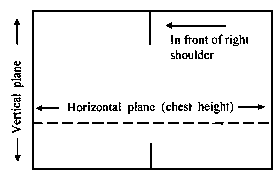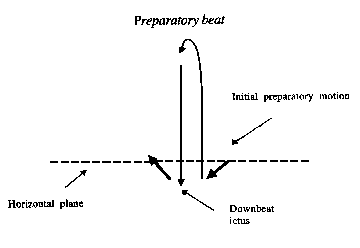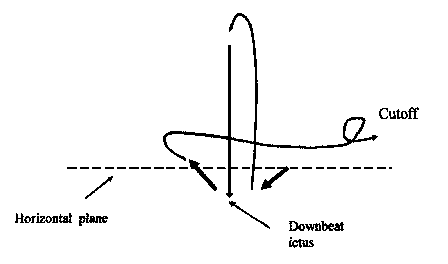The Horizontal, Vertical and Intensity Planes
The Preparatory Beat and the Downbeat
The Up-ictus
The Cutoff
The Horizontal, Vertical and Intensity Planes
The horizontal, vertical and intensity planes mark out the space in which conducting gestures take place. Although there is some variation among conductors in this respect, the horizontal plane (from the left to the right of the body) is generally set at the chest area.
The vertical plane is centred slightly to the right of centre in front of the right shoulder. It extends from the conductor’s waist to the top of the head. Some textbooks on conducting suggest that the focus point, or fulcrum, where these two planes meet is also the general area where the left hand should rest when not in use. 
Space prohibits a detailed discussion of the role of the intensity plane. Basically, it refers to the extension and retraction of the arms closer to and away from the musicians. This plane is used to gain greater attention from the ensemble, either by reaching towards the players or by retracting the arms and executing smaller gestures. Both hands may use this plane simultaneously or one hand only may be employed.
The preparatory beat and the downbeat
An inadequately executed preparatory beat by the conductor is a common cause of poor attack by the ensemble. Before beginning this beat it is important to assume the authoritative stance described earlier, with the arms and hands in the appropriate positions. The conductor should then make eye contact with the performers before executing the movement shown in the accompanying diagram. 
As the hands move upward from the ready position, the conductor should inhale rather obviously as an additional indication of his intention. The ictus, sometimes known as the attack, is the actual starting point of the sound. Its position is indicated to the performers in our diagram by the initial preparatory motion.
Not all conductors execute a downbeat in precisely this way, but it is often recommended as an important means of ensuring a clean attack. Note also that both the preparatory and downbeat motions generally involve a snap or rebound just after the hand reaches the imaginary horizontal plane. This rebound takes place at the wrist rather than of the forearm, and should generally be no more than half the length of the beat itself. This is to avoid the suggestion that the following beat is also a downbeat (the one-beat pattern described later is an exception). Only use the forearm when you want to indicate a heavy marcato style. Each beat in any given pattern should have some rebound to it, with a legato style having more rebound than a staccato style. Anthony Maiello suggests that “The length and speed of the rebound indicates the actual amount of decay desired. The longer the rebound, the longer the decay and vice versa” [Conducting: A Hands On Approach, Belwin Mills, Miami, 1996, p.21]
Practicing this sequence in front of a mirror can help, but it also important to practice the downbeat repeatedly in front of a live ensemble. This is the only way to ensure that one’s gestures are clear and definite. The initial preparatory beat can also give the performers other important information. Tempo is set by the speed of the sequence, volume by its size (larger gestures indicate louder volumes) and the style (legato, marcato and staccato) by the extent of the rebound from the horizontal plane.
A few conductors beat time in quite a different manner, with the ictus occurring at the top of the rebound instead of at the bottom of the beat.
The fermata and cutoff is yet another technical skill that should be mastered before moving on to the basic time beating patterns. Many authorities approach this as an extension of the downbeat sequence described above. A fermata is indicated as follows. After executing the downbeat do not stop after the rebound from the ictus, but move the hand horizontally towards the right in the manner shown in the illustration. 
The continuous motion – sometimes called “travel” -- of the hand indicates that the conductor wishes the sound to continue. Sometimes, a fermata is executed using both hands. If you are doing this, then the left hand should move away from the body in mirror-like fashion. Executing a quick loop and then stopping all movement indicates the cutoff.












